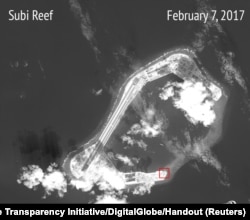Southeast Asia, seeking a long term agreement to settle disputes in the South China Sea, faces new challenges as China moves to extend its regional influence with plans for a scientific station on islets close to the Philippines.
The concerns come as analysts say the United States’ Asia policy is currently focused on rising tensions on the Korean Peninsula.
Philippine President, Rodrigo Duterte, currently chairman of the Association of South East Asian Nations (ASEAN), this week held talks with regional partners Myanmar and Thailand.
Freedom of navigation
Following talks in Bangkok with Thailand’s Prime Minister Prayut Chan-o-cha, the countries agreed to promote freedom of navigation in the South China Sea “as a core value in securing peace and prosperity in the region.”
“Maintaining peace, stability and security as well as respecting freedom of navigation and over-flight in the South China Sea, are in the interests of all countries, within an outside the region, as they are fundamental conditions for growth, development and prosperity,” Duterte said.
Thai analyst Kavi Chongkittavorn said Thailand and the Philippines hope to have a code of conduct framework completed by July, to then add “nuts and bolts” to the agreement.
Code of conduct
ASEAN’s long time goal has been to press ahead with implementation of a 2002 declaration on the conduct of parties in the South China Sea or code of conduct. But Beijing has long resisted completing a legally binding code, leading to divisions within ASEAN.
However, China is to host a meeting of ASEAN in May on the Code of Conduct framework, with diplomats hoping on progress towards a legally-binding document to manage regional disputes.
Environmental monitoring station
But the talks in Bangkok follow official Chinese media reports saying Beijing may be preparing to install an environmental monitoring station at Scarborough Shoal, which sits inside the Philippines’ 200 nautical mile exclusive economic zone. The Chinese foreign ministry denied those reports Wednesday.
In 2016 China pressed ahead with consolidating its military position on the Spratly Islands, including runways on Fiery Cross, Subi and Mischief Reefs, reinforced hangers to accommodate fighter jets as well as other defenses, improving port facilities and installing radar.
The U.S., which has carried out military exercises near Scarborough Shoal, strongly opposed any Chinese construction there under former President Obama.
US attention now focused on North Korea
But analysts say President Donald Trump’s administration is preoccupied with tensions on the Korean peninsula, where North Korea has been testing rockets.
Carl Thayer, a defense analyst at Australia’s University of New South Wales, said Washington’s attention has shifted from the South China Sea issue.
“The South China Sea has been lost. It’s just not on the radar. It is there but it’s like a pot that’s been put on the burner and the heat has been turned down. Everybody else is looking at not moving a fire on the main cooking pot — and that’s North Korea,” Thayer said.
China is strengthening claims
Analysts say uncertainties over the U.S. policy towards the South China Sea and “a comprehensive strategy for Asia” generally has enabled China to adopt a stronger position to its claims to the region.
James Chin, director of the Asia Institute at the University of Tasmania, said the uncertainties over the U.S. policy have led to disappointment within ASEAN.
“Now they think it’s going to be a stalemate and people are thinking that the Americans only worry about North Korea and the North Korean crisis. They don’t worry about the South China Sea,” Chin said.
“Now all bets are off. The problem with this approach it that the longer you leave the South China Sea alone, it means to give more time to the Chinese to keep building military bases,” he said.
China nears de-facto control
Once China builds on reclaimed land on the Scarborough Shoal, “it means they will have de-facto control of the South China Sea.”
Thayer said a Chinese airfield on the Shoal would be strategically significant completing a triangle linking Woody Island in the Parcels, the occupied features in the Spratly Islands, giving China “the ability to monitor all aircraft and surface ships passing over or through the South China Sea.”
“[But] they will allow freedom of navigation because China is essentially a trading nation. So they will not disturb the freedom of navigation – so that’s the positive,” said Chin.
China claims much of the South China Sea through the so-called nine dash line that extends near Malaysia, Brunei, the Philippines and Vietnam.













